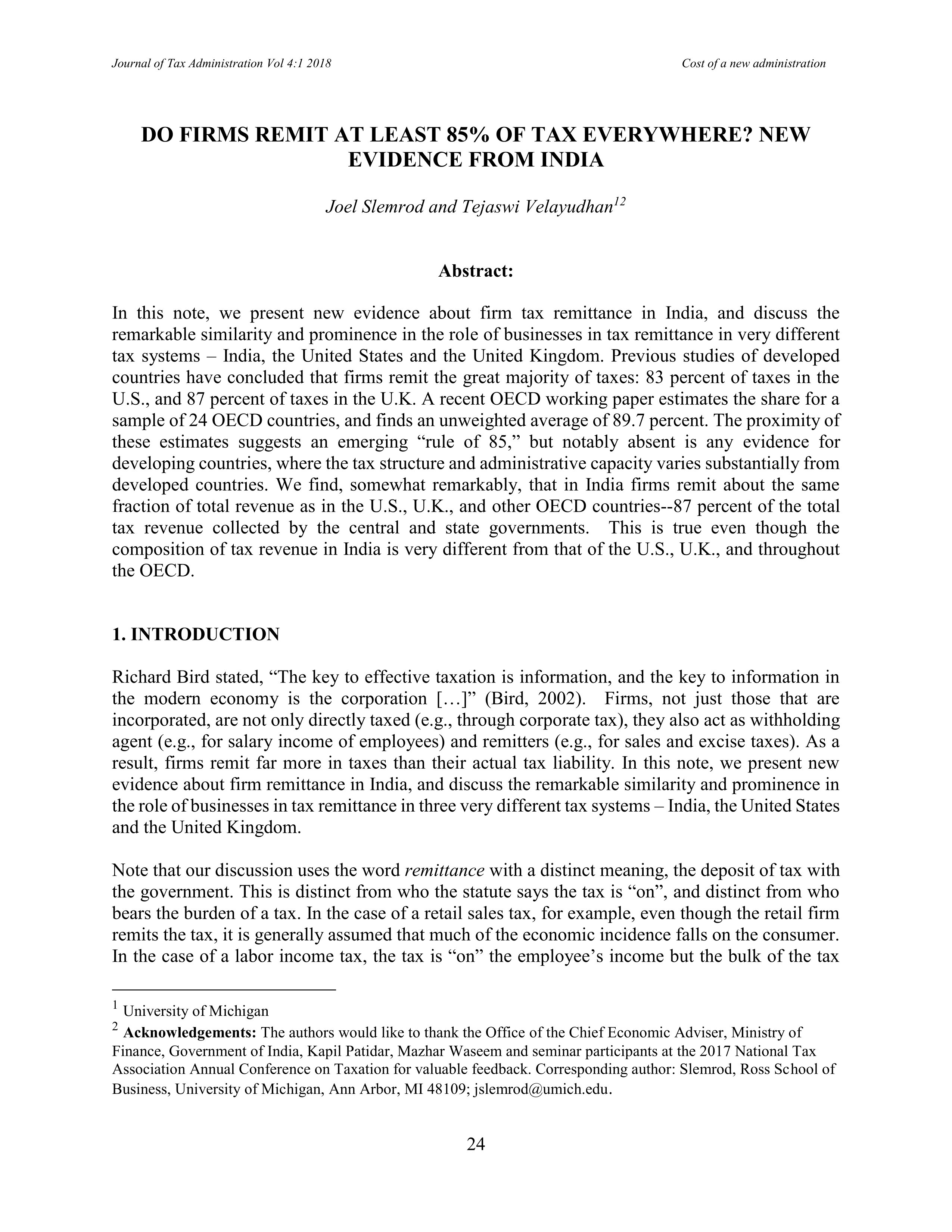Do Firms Remit At Least 85% of Tax Everywhere? New Evidence from India
Abstract
In this note, we present new evidence about firm tax remittance in India, and discuss the remarkable similarity and prominence in the role of businesses in tax remittance in very different tax systems – India, the United States and the United Kingdom. Previous studies of developed countries have concluded that firms remit the great majority of taxes: 83 percent of taxes in the U.S., and 87 percent of taxes in the U.K. A recent OECD working paper estimates the share for a sample of 24 OECD countries, and finds an unweighted average of 89.7 percent. The proximity of these estimates suggests an emerging “rule of 85,” but notably absent is any evidence for developing countries, where the tax structure and administrative capacity varies substantially from developed countries. We find, somewhat remarkably, that in India firms remit about the same fraction of total revenue as in the U.S., U.K., and other OECD countries - 87 percent of the total tax revenue collected by the central and state governments. This is true even though the composition of tax revenue in India is very different from that of the U.S., U.K., and throughout the OECD.
References
Besley, Timothy, Torsten Persson. (2014). Why Do Developing Countries Tax So Little? Journal of Economic Perspectives 28 (4), pp. 99-120.
Bird, Richard. (2002). Why Tax Corporations? Bulletin for International Fiscal Documentation 52, pp. 194-203.
Christensen, Kevin, Robert Cline, and Tom Neubig. (2001). Total Corporate Taxation: ‘Hidden,’ Above-the-Line, Non-Income Taxes. National Tax Journal 54(3), pp. 495-506.
Comptroller and Auditor General of India. (2013). Report of the Comptroller and Auditor General of India for the year ended March 2013.
Dusek, Libor and Sutirtha Bagchi. (2016). Are Efficient Taxes Responsible for Big Government? Evidence from Tax Withholding, Working Paper, Villanova University.
Gordon, Roger and Wei Li. (2009). Tax Structures in Developing Countries: Many Puzzles and a Possible Explanation. Journal of Public Economics, 93(7), pp. 855- 866
Government of India. (2016). Details of Revenue Collection (Direct and Indirect Taxes) from 1995-96. http://dor.gov.in/revenue_previous_ctc, accessed 5/27/2016.
Hsieh, Chang-Tai and Peter Klenow. (2014). The Life Cycle of Plants in India and Mexico. The Quarterly Journal of Economics, 129(3), pp. 1035-1084.
Internal Revenue Service. (2012). Overview Tax Gap for Tax Year 2006. https://www.irs.gov/pub/newsroom/overview_tax_gap_2006.pdf.
Jensen, Anders. (2016). Employment Structures and the Rise of the Modern Tax System. Working Paper, Kennedy School at Harvard University.
Milanez, Anna. (2017). Legal Tax Liability, Legal Remittance Responsibility & Tax Incidence: Three Dimensions of Business Taxation. OECD Taxation Working Papers, No. 32
National Sample Survey Office. (2013). Employment and Unemployment Situation in India. National Sample Survey Report, No. 554, Government of India.
Shaw, Jonathan, Joel Slemrod, and John Whiting. (2010). Administration and Compliance. In J. Mirrlees, S. Adam, T. Besley, R. Blundell, S. Bond, R. Chote, M. Gammie, P. Johnson, G. Myles and J. Poterba (Eds.), Dimensions of Tax Design: The Mirrlees Review, Chapter 12, 1100-12-3. Oxford, UK: Oxford University Press.
Slemrod, Joel. (2008). Does it Matter Who Writes the Check to the Government? The Economics of Tax Remittance. National Tax Journal, 61(2), pp. 251-275.

Downloads
Published
How to Cite
Issue
Section
License
Copyright (c) 2018 Joel Slemrod, Tejaswi Velayudhan

This work is licensed under a Creative Commons Attribution 4.0 International License.
Our open access status means that authors retain the copyright of their work. However, all papers published in JOTA are done so under a Creative Commons Attribution 4.0 International license (CC BY). This means that others can share and/or adapt your work without your permission as long as they follow certain rules, including attributing your work correctly.
You can learn more about this on our Open Access, Licensing, and Copyright Policies page.



